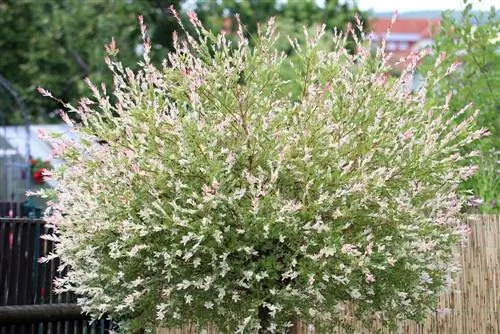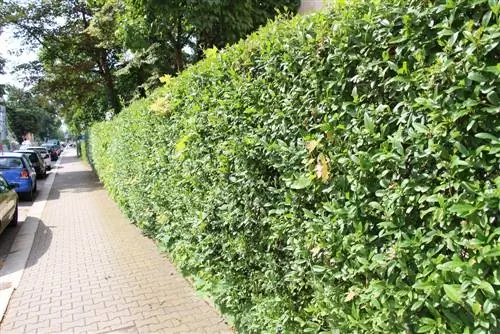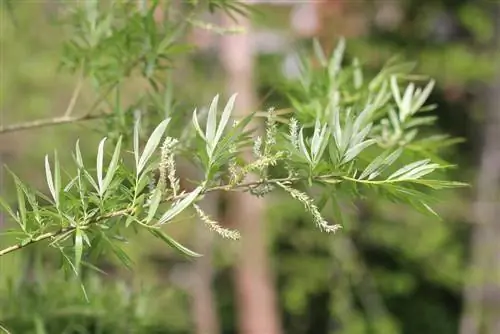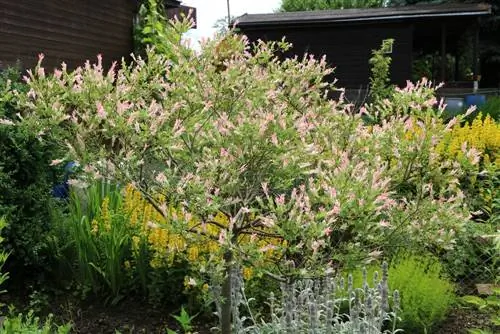- Author admin [email protected].
- Public 2023-12-17 03:39.
- Last modified 2025-06-01 06:48.
The neat willow shrub originally comes from the East Asian region, but the harlequin willow with the botanical name “Salix integra” has long since conquered Central European gardens. In Japan the shrub is called “Hakuro Nishiki”.
Harlequin Willow Care
The willow shrub is an ideal plant for those new to gardening. The short trunk is refined so that the plant no longer grows in height, but only slightly in width. Even as the harlequin willow gets older, the trunk only becomes thicker. For this reason, the tree can serve as a decorative eye-catcher in a large pot on the balcony or terrace.
Location and Soil for Harlequin Willows
The location should be sunny to partially shaded. If the Asian ornamental garden plant is only in the shade, the leaves may turn completely green. That's not a bad thing in itself, but it's the pretty green and white to the pink speckled notes that make the popular plant so beautiful. The harlequin willow does not place any great demands on the properties of the soil. It can handle light soil just as well as heavy ground. If there is anything she prefers, it would be sandy soil. However, the soil should not be too dense, as this leads to waterlogging, which the plant does not benefit from.
Watering and fertilizing
The Harlequin willow needs enough water. The plant should be watered daily, especially after planting, so that the tree quickly feels comfortable. Fertilization is usually done once a year - with care. If the plant receives too much fertilizer, it reacts with noticeable signs of illness. The right time to add fertilizer is when the plant sprouts again. A second fertilizer application can possibly be made a little later in the year, depending on the condition of the tree. But fertilization is over by August at the latest. The branches must be properly matured as winter approaches. However, if the plant is provided with fertilizer again in autumn, the branches would still be busy growing when the cold season arrives.
Overwintering Harlequin Willow
If the plant is in a pot, it should be covered with some leaves over the winter months. No special protection is necessary for a harlequin willow planted in the garden as the plant is hardy.
Cut back the willow bush properly
Without severe pruning, the willow bush will become completely wild. In addition, older shoots become woody, which would ultimately lead to bald and unsightly areas. If the willow is cut back in winter or early spring, it will develop a beautiful and dense crown.
What should you pay attention to when cutting back?
- We don't cut when it's frosty or when the sun is shining
- Since the tree is without leaves in winter, diseased or dead branches can be easily identified; these must be completely removed.
- The next step is on the shoots. These will be radically shortened. Old shoots are completely removed.
- The he althy branches are trimmed by about 2/3.
- If branches are very close together, they are cut out.
No small stubs should remain at the base - i.e. directly on the trunk - as these cause unfavorable growth over time. In general, the harlequin willow can be cut back so far that a round ball with an approximate diameter of 30 cm is left.
If you would like to give your tree a fresh look in the form of a topiary cut, you can do so, but the strong growth means that the contours of the cut disappear relatively quickly.
Avoid and recognize diseases
Although the Asian ornamental garden plant is relatively undemanding, it is not completely immune to harmful influences. Careful observation provides information about emerging illnesses or other troubles. If the plant gets too much sun, the shoot tips can turn brown. The same appearance occurs with too little water. However, both cases can be ironed out with a correction. If the plant is moved to a different location or the water supply is increased, the brown tips will grow out on their own. This takes time, but is still more useful than simply removing the spots with scissors or a knife. This is because the grafting is quickly cut into, which could seriously damage the plant.
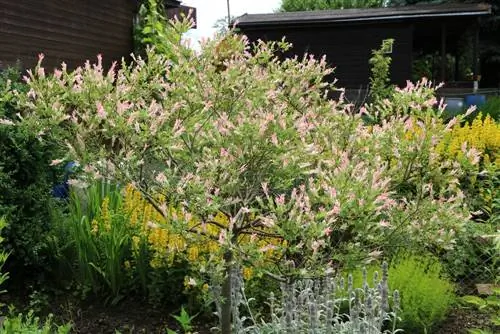
If the brown leaves or shoots do not grow out despite all measures, the nutrient supply should be checked. Did she receive too much or too little fertilizer? That could be a possible reason. But waterlogging also plays a role in this context. This is especially true if the willow bush is kept in a bucket. In general, the tree recovers surprisingly quickly from care errors.
Even when cutting, there are hardly any serious mistakes that can happen, except that branches that are too close are not cut out. Because of the abundant growth of the plant, it deprives itself of the air and the necessary light. If these branches, which are close together, are not trimmed, this will become noticeable at some point in the growth of the crown. The plant may then look stunted simply because its leaves in the inner part of the crown no longer receive enough light. Nevertheless, this small care mistake can be easily remedied the next time you trim. Crop boldly, that's the motto. This effectively prevents diseases and allows the harlequin willow to do what it does best: looking beautiful.
What you should know about the Harlequin Willow in brief
A harlequin willow is an asset to any garden, balcony or terrace. The tree's undemanding nature guarantees that mistakes in care are quickly forgiven. If the plant feels comfortable, it will reward you with magnificent growth.
Location
The Harlequin Willow does not place many demands on its location. It should be sunny to partially shaded. A completely shady spot is not ideal.
Planting substrate
The tree doesn't have many conditions on the ground either. It can cope with almost anything, whether light or heavy soil, it even grows and thrives in a pot with potted soil. However, the harlequin willow prefers sandy soil.
Care errors
The tree does not like waterlogging and soil compaction. These lead to stunting and make it susceptible to disease.
Fertilize
Fertilized with complete fertilizer after new growth. You can fertilize again later in the year. From August onwards there is no more fertilization so that the branches can mature well and survive the winter.
Cut
The Harlequin willow needs severe pruning. Otherwise it will be completely out of shape and older shoots also tend to form hardwood. This is how bald spots arise. In addition, the crown becomes denser as a result of the cut. As with most trees, pruning should be done in winter or early spring. You don't cut in frost or sunshine. Dead or diseased branches are completely removed. Otherwise, shorten the shoots by 2/3. On the one hand, the foliage color is retained and on the other hand, the branches can branch out close to the base. This way the crown looks better and becomes denser. After pruning, the pasture needs a lot of nutrients. It is important that no stubs remain at the base, this is unfavorable for the shape and appearance. Old shoots are also susceptible to disease and should be cut away.


